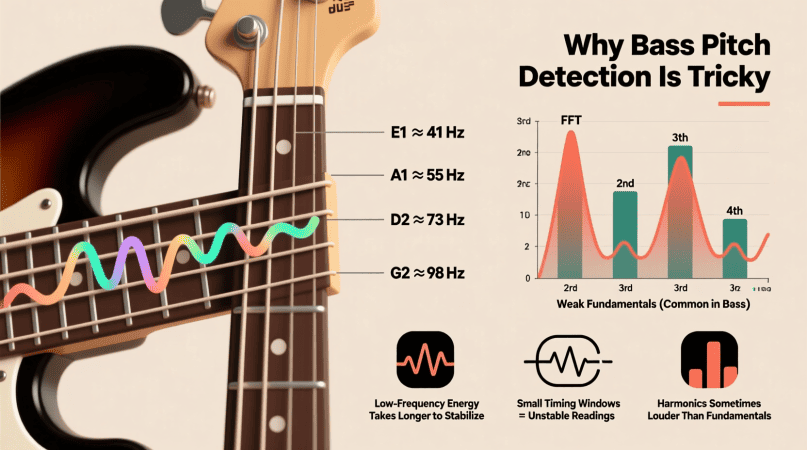
Bass players carry the groove. If your strings drift out of tune, the whole band feels it. The challenge with bass is that low frequencies are harder to hear precisely. That’s where pitch detection methods step in—they give you clear, instant feedback on whether your notes are sharp, flat, or locked in.
Why Pitch Detection Is Essential for Bassists
- Low notes are tricky to judge by ear—detectors make them visible.
- Real-time feedback shows you exactly how stable your intonation is.
- Consistency with the band keeps your bass lines sitting tight with drums and guitars.
- Ear training: Over time, your eyes confirm what your ears are learning.
The Best Pitch Detection Methods for Bass Guitar
1. Clip-On Tuners
- Attach to the bass headstock and read string vibration.
- Work well in noisy rehearsal rooms.
- Quick and reliable, though less detailed than software graphs.
2. App-Based Tuners
- Use your phone’s mic.
- Convenient and often free.
- Accuracy varies depending on mic quality and background noise.
3. Pedal and Rack Tuners
- Plug straight into your rig.
- High accuracy, great for live shows.
- More gear to carry, but stage-proven.
4. Software Pitch Detectors
- Use a mic or line input.
- Display real-time pitch graphs, letting you see drift as you play.
- Perfect for practicing intonation, not just tuning.
👉 Start by checking your open strings with the Voice Pitch Analyzer to see how cleanly they sit on E, A, D, and G.
How to Use Pitch Detection in Practice
- Tune Open Strings
- Use a pitch detector to set E, A, D, and G exactly.
- Play Scales Slowly
- Watch the detector for shifts as you move up the neck.
👉 The Singing Pitch Detector works for instruments too, showing instant corrections while you practice scales and arpeggios.
- Test Harmonics and Fretted Notes
- Compare 12th fret harmonics with fretted 12th notes.
- Use the detector to confirm they line up.
- Track Intonation in Songs
- Play through a bassline and monitor your accuracy.
👉 For longer sessions, the Real-Time Pitch Detection tool logs stability across riffs and chord progressions.
Pro Tips for Better Tuning and Intonation
- Warm up strings: Play for a few minutes before tuning to stabilize tension.
- Always tune up: If you overshoot, drop slightly flat and then raise back to pitch.
- Check harmonics: They reveal small intonation issues up the neck.
- Quiet room = better readings: Background noise can confuse mic-based detectors.
Pitch Detector is a project by Ornella, blending audio engineering and web technology to deliver precise, real-time pitch detection through your browser. Designed for musicians, producers, and learners who want fast, accurate tuning without installing any software.
